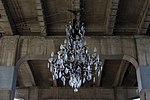Vancouver House
Bjarke Ingels buildingsSkyscrapers in Vancouver

Vancouver House is a neo-futurist residential skyscraper in Vancouver, British Columbia, Canada.
Excerpt from the Wikipedia article Vancouver House (License: CC BY-SA 3.0, Authors, Images).Vancouver House
Howe Street, Vancouver
Geographical coordinates (GPS) Address Nearby Places Show on map
Geographical coordinates (GPS)
| Latitude | Longitude |
|---|---|
| N 49.275055555556 ° | E -123.13088888889 ° |
Address
Vancouver House
Howe Street 1480
V6Z Vancouver
British Columbia, Canada
Open on Google Maps








